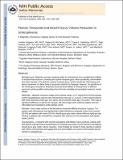| dc.contributor.author | Hirayasu, Yoshio | |
| dc.contributor.author | McCarley, Robert William | |
| dc.contributor.author | Salisbury, Dean F. | |
| dc.contributor.author | Tanaka, Shin | |
| dc.contributor.author | Soo Kwon, Jun | |
| dc.contributor.author | Frumin, Melissa | |
| dc.contributor.author | Snyderman, Danielle | |
| dc.contributor.author | Yurgelun-Todd, Deborah | |
| dc.contributor.author | Kikinis, Ron | |
| dc.contributor.author | Jolesz, Ferenc A. | |
| dc.contributor.author | Shenton, Martha Elizabeth | |
| dc.date.accessioned | 2016-09-15T18:48:11Z | |
| dc.date.issued | 2000 | |
| dc.identifier.citation | Hirayasu, Yoshio, Robert W. McCarley, Dean F. Salisbury, Shin Tanaka, Jun Soo Kwon, Melissa Frumin, Danielle Snyderman, Deborah Yurgelun-Todd, Ron Kikinis, Ferenc A. Jolesz, and Martha E. Shenton. 2000. Planum Temporale and Heschl Gyrus Volume Reduction in Schizophrenia. Arch Gen Psychiatry 57, no. 7: 692–699. | en_US |
| dc.identifier.issn | 0003-990X | en_US |
| dc.identifier.uri | http://nrs.harvard.edu/urn-3:HUL.InstRepos:28520159 | |
| dc.description.abstract | Background: Magnetic resonance imaging studies in schizophrenia have revealed abnormalities in temporal lobe structures, including the superior temporal gyrus. More specifically, abnormalities have been reported in the posterior superior temporal gyrus, which includes the Heschl gyrus and planum temporale, the latter being an important substrate for language. However, the specificity of the Heschl gyrus and planum temporale structural abnormalities to schizophrenia vs affective psychosis, and the possible confounding roles of chronic morbidity and neuroleptic treatment, remain unclear. Methods: Magnetic resonance images were acquired using a 1.5-T magnet from 20 first-episode (at first hospitalization) patients with schizophrenia (mean age, 27.3 years), 24 first-episode patients with manic psychosis (mean age, 23.6 years), and 22 controls (mean age, 24.5 years). There was no significant difference in age for the 3 groups. All brain images were uniformly aligned and then reformatted and resampled to yield isotropic voxels. Results: Gray matter volume of the left planum temporale differed among the 3 groups. The patients with schizophrenia had significantly smaller left planum temporale volume than controls (20.0%) and patients with mania (20.0%). Heschl gyrus gray matter volume (left and right) was also reduced in patients with schizophrenia compared with controls (13.1%) and patients with bipolar mania (16.8%). Conclusions: Compared with controls and patients with bipolar manic psychosis, patients with first-episode schizophrenia showed left planum temporale gray matter volume reduction and bilateral Heschl gyrus gray matter volume reduction. These findings are similar to those reported in patients with chronic schizophrenia and suggest that such abnormalities are present at first episode and are specific to schizophrenia. | en_US |
| dc.language.iso | en_US | en_US |
| dc.publisher | American Medical Association | en_US |
| dc.relation.isversionof | http://archpsyc.jamanetwork.com/article.aspx?articleid=481629 | en_US |
| dc.relation.hasversion | https://www.ncbi.nlm.nih.gov/pmc/articles/PMC2850271/ | en_US |
| dash.license | LAA | |
| dc.title | Planum Temporale and Heschl Gyrus Volume Reduction in Schizophrenia | en_US |
| dc.type | Journal Article | en_US |
| dc.description.version | Accepted Manuscript | en_US |
| dc.relation.journal | Archives of General Psychiatry | en_US |
| dash.depositing.author | Shenton, Martha Elizabeth | |
| dc.date.available | 2016-09-15T18:48:11Z | |
| dash.identifier.orcid | 0000-0003-4235-7879 | en_US |
| dash.contributor.affiliated | Frumin, Melissa | |
| dash.contributor.affiliated | Yurgelun-Todd, Deborah | |
| dash.contributor.affiliated | Jolesz, Ferenc | |
| dash.contributor.affiliated | Kikinis, Ron | |
| dash.contributor.affiliated | Shenton, Martha | |
| dash.contributor.affiliated | McCarley, Robert William | |
| dc.identifier.orcid | 0000-0001-5705-7495 | |


